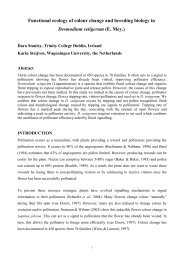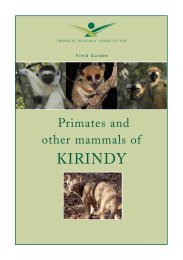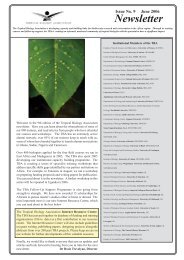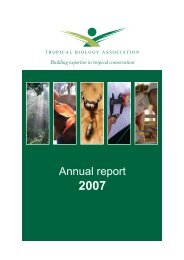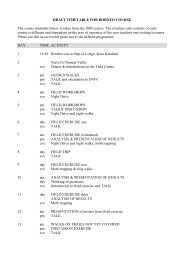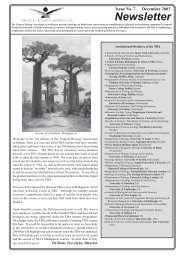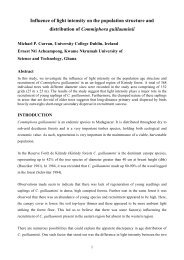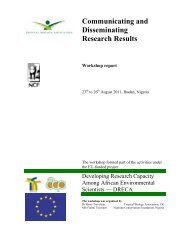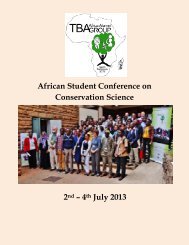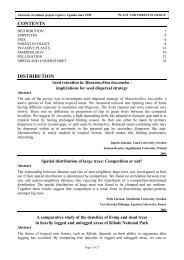Download TAAG Book of Abstracts - Tropical Biology Association
Download TAAG Book of Abstracts - Tropical Biology Association
Download TAAG Book of Abstracts - Tropical Biology Association
You also want an ePaper? Increase the reach of your titles
YUMPU automatically turns print PDFs into web optimized ePapers that Google loves.
Status <strong>of</strong> Soil Properties and Wheat Production under<br />
Parkland Agr<strong>of</strong>orestry at Beressa Watershed in Gurage<br />
Zone, Central Ethiopia<br />
Gosaye Degu Belay<br />
Hawassa University, WondoGenet Collage <strong>of</strong> Forestry<br />
and Natural Resources, Ethiopia<br />
Email for correspondence:gosayede@yahoo.com<br />
Abstract<br />
This study was conducted in Gurage administrative Zone<br />
<strong>of</strong> Central Ethiopia and was intended to assess and<br />
document the dimensional effect <strong>of</strong> trees (Faidherbia<br />
albida, Cordia africana, Croton macrostachyus, Persea<br />
americana) on soil fertility and wheat crop. In the<br />
selection <strong>of</strong> appropriate trees, uniformity in topography<br />
and history <strong>of</strong> cropping practice was considered. The<br />
sampling procedure for agronomy and soil properties<br />
under the parkland tree species at different radii (0.5m,<br />
1m, 2m and 10m) from tree trunk and soil layer (0-20cm<br />
& 20-40cm) was followed accordingly. Different soil<br />
physical properties (texture, moisture, and soil bulk<br />
density) and chemical properties (total nitrogen,<br />
available phosphorus, cation exchange capacity (CEC),<br />
pH, organic carbon, electrical conductivity (EC),<br />
potassium (K), Calcium (Ca), Magnesium (Mg) and<br />
Sodium (Na)) were analyzed. Based on the laboratory<br />
result large amount <strong>of</strong> soil nutrient is found on top soil<br />
layer than bottom and near to the tree trunk than away.<br />
Specifically significant differences were observed<br />
between 0-20cm and 20-40cm depths for bulk density<br />
under C. mycrostachus compared to the control. Little<br />
variation was observed for texture among the different<br />
tree species and distances. Soil pH and electrical<br />
conductivity were significantly different at 0-20cm and<br />
20-40cm depths for soil sample taken from P.<br />
americana. Exchangeable potassium shows significant<br />
difference between the two depths at one and two<br />
meter from all parkland tree species. Based on the<br />
agronomic result <strong>of</strong> the research, F. albida has increased<br />
the yield more than 50% as compared with the control.<br />
However for the rest tree species (C. africana, C.<br />
macrostachyus, and P. americana) the highest yield is at<br />
the control. As a general recommendation awareness <strong>of</strong><br />
the local people about the economic importance <strong>of</strong><br />
F.albida tree should be created through extension<br />
services.<br />
The Vulnerability <strong>of</strong> the Coast <strong>of</strong> Liberia to Marine Oil<br />
Spills: Implications for Biodiversity and Renewable<br />
Natural Resource Utilization<br />
Darlington Saykay Tuagben<br />
USAID, Liberia<br />
Email for correspondence:d.tuagben@gmail.com<br />
Abstract<br />
The West African coastline has become a “hotspot” for<br />
oil production and 17 oil exploration blocks have been<br />
designated <strong>of</strong>f Liberia’s 579 km coastline which supports<br />
about 60% <strong>of</strong> the human population. There is a potential<br />
for conflict between oil production, existing human<br />
activities and biodiversity. This study aims to establish<br />
the level <strong>of</strong> dependency <strong>of</strong> rural coastal households on<br />
natural resources and assess this potential conflict with<br />
a goal to contribute to biodiversity conservation efforts<br />
in Liberia. Published literatures were reviewed to assess<br />
the vulnerability <strong>of</strong> coastal and marine resources and<br />
inhabitants to oil spills events followed by household<br />
surveys in seven coastal counties adjacent to ten <strong>of</strong> the<br />
17 <strong>of</strong>fshore oil exploration blocks. Average household<br />
size (N=10) was similar in all sites. The coastal zone <strong>of</strong><br />
Liberia comprises sensitive environments all <strong>of</strong> which<br />
are vulnerable to oil pollution to varying degrees.<br />
Mangroves, estuaries and coastal lagoons are important<br />
spawning, roosting and breeding sites for fish and other<br />
wildlife, whereas sandy beaches are used for recreation<br />
and breeding grounds for five species <strong>of</strong> marine turtles.<br />
Coastal inhabitants rely heavily on the utilization <strong>of</strong><br />
coastal and marine resources for their livelihoods and<br />
income. Fishing and several other income sources might<br />
be lost in the event <strong>of</strong> a large oil spill, increasing poverty<br />
and food insecurity. There is an urgent need to develop<br />
an oil spill contingency plan and a waste management<br />
plan that will consider both biodiversity conservation<br />
and human safety and wellbeing.<br />
Keywords: Oil spills, Coastal vulnerability, Community<br />
livelihoods, Biodiversity conservation, Human safety,<br />
Contingency plan<br />
Keywords: agronomy, soil physical properties,<br />
agr<strong>of</strong>orestry, Faidherbia albida<br />
<strong>TAAG</strong> First African Student’s Conference, Nairobi. 2-4 July, 2013 57




